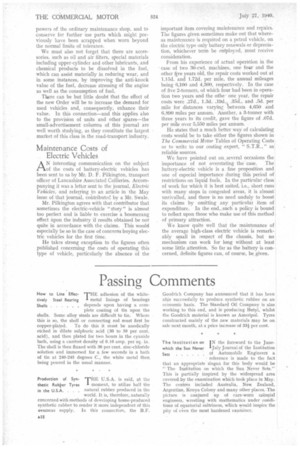Passing Comments
Page 14

Page 15

If you've noticed an error in this article please click here to report it so we can fix it.
How to Line EffecTHE adhesion of the white
tively Steel Bearing metal linings of bearings Shells . . depends upon having a complete coating of tin upon the shells. Some alloy steels are difficult to tin. Where this is so, the shell or connecting rod must first be
copper-plated. To do this it must be anodically etched in dilute sulphuric acid (30 to 50 per cent. acid), and then plated for two hours in the cyanide bath, using a currbrit density of 0.16 amp. per sq. in. The shell is then fluxed with 30 per cent. zinc-chloride solution and immersed for a few seconds in a bath of tin at 240-245 degrees C., the white metal then, being poured in the usual manner.
THE U.S.A, is said, at the I moment, to utilize half the natural rubber produced in the world. It is, therefore, naturally concerned with methods of developing home-produced synthetic rubber to render it more independent of this overseas supply. In this connection, the B.F.
Production of Synthetic Ru4er Tyres
in the U.S.A. . . Goodrich Company has announced that it has been able successfully to produce synthetic rubber on an economic basis. The Standard Oil Company is also working to this end, and is producing Butyl, whilst the Goodrich material is known as Ameripol. Tyres constructed mainly of the new materials may be on sale next month, at a price increase of 33i per cent.
IN the foreword to the Juneljuly Journal of the Institution of Automobile Engineers a reference is made to the fact that an appropriate slogan for this body would be " The Institution on which the Sun Never Sets." This is partially inspired by the widespread area covered by the examination which took place in May. The centres included Australia, New Zealand, Argentine, Kenya Colony and many other places. The picture is conjured up of care-worn colonial engineers, wrestling with mathematics under conditions of equatorial sultriness, which would inspire the pity of even the most hardened examiner. The Institution on which the Sun Never Sets
Sugarless Tea Even at an Important Sugar Factory . . .
OUR
was when costs expert S.T.R. particularly amused, visiting the Brigg
Factory of the British Sugar Corporation and having tea with Mr. McCloy, the agriculturist, to learn that, because of rationing, members of their staff were unable, except occasionally, to have sugar in their tea. Meanwhile, in the factory warehouse, lay thousands of tons of sugar.
Combined Road-rail IT is a common enough Tickets are by No 'expression that there is
Means a Novelty . nothing new under the sun. It might, however, have been thought reasonable that road-rail tickets would be an exception, at least that they must have been new within the past couple of decades. Apparently that is not so, for such tickets were actually issued as long ago as 1850. In those days passengers travelled by
coach from villages to the nearest railway station, where the coach was placed on a truck and that truck attached to an ordinary passenger train. It was in connection with these services that road-rail tickets were issued.
Delay and Loss THE daily newspapers,
Caused by Ministerial I always the last to appreciate Prejudice the importance of road trans
port, are beginning to realize the hardships under which road haulage is carried on, especially as regards fuel supplies. What is more, realization has come that these difficulties are a national concern, and are reacting to the disadvantage of our war effort. It is reported that a consignment of 20,000 articles, urgently needed for home defence, has been lost on rail, simply because the Ministry of Transport officials took a week to decide —unfavourably—as to whether petrol was to be made available for the transport of those articles,




















































